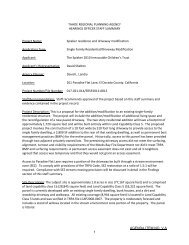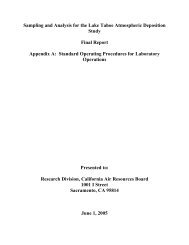FEIS - Tahoe Regional Planning Agency
FEIS - Tahoe Regional Planning Agency
FEIS - Tahoe Regional Planning Agency
You also want an ePaper? Increase the reach of your titles
YUMPU automatically turns print PDFs into web optimized ePapers that Google loves.
REVISIONS TO THE DEIS<br />
B o u l d e r B a y C o m m u n i t y E n h a n c e m e n t P r o g r a m P r o j e c t E I S<br />
• Boulder Bay shall help pay for trash removal operations at Speedboat Beach<br />
by working with Placer County to increase the number of trash removal<br />
visits to the Beach during peak use periods. Based on its request, Placer<br />
County shall take the lead in securing an agreement with Boulder Bay to<br />
help offset the costs of the additional trash removal operations.<br />
Mitigation Measure REC-1B has been added to DEIS Chapter 4.6 as follows:<br />
REC-1B: Stateline Lookout Access Improvements.<br />
Boulder Bay will work with the USDA Forest Service to identify areas where<br />
additional access signage may be placed and if access point improvements are<br />
warranted. If necessary, such improvements will be funded by Boulder Bay.<br />
Recreation access signage or information shall be provided at the resort,<br />
informing guests of trailhead locations and access routes. Boulder Bay will<br />
work with the USDA Forest Service to improve existing parking areas and<br />
signage to reduce erosion potential. Coordination shall occur prior to<br />
construction and improvements, if approved by the USDA Forest Service, will<br />
be immediately funded by Boulder Bay and implemented within the first year of<br />
resort operation.<br />
Page 4.7-2 of DEIS Chapter 4.7 has been revised as follows:<br />
Ethnography<br />
The project area lies entirely within the territory of the Hokan-speaking Washoe<br />
people. While they were an informal and flexible political collectivity, Washoe<br />
ethnography hints at a level of technological specialization and social complexity for<br />
Washoe groups, non-characteristic of their surrounding neighbors in the Great Basin.<br />
Semisedentism and higher population densities, concepts of private property, and<br />
communal labor and ownership were reported and may have developed in<br />
conjunction with their residential and subsistence resource stability (d’Azevedo<br />
1986:473-476).<br />
Lake <strong>Tahoe</strong> was and remains both the spiritual and physical center of the Washoe<br />
world. The Washoe lived along its shores, and the locations of several Washoe<br />
encampments in the Lake <strong>Tahoe</strong> Basin have been reported. The project vicinity is<br />
near two important Washoe fishing campsites, ImgiwO'tha and MathOcahuwo'tha<br />
(d’Azevedo 1986:473-476).<br />
Currently, The Washoe Tribe is are a federally recognized tribe by the U.S.<br />
Government, is a sovereign government and has have maintained an established<br />
land base. Its approximately 1,200 1,600 tribal members are governed by a tribal<br />
council that consists of members of the Carson, Dresslerville, Woodfords, Stewart<br />
and Reno-Sparks communities, Indian groups, as well as a significant number of<br />
tribal members from non-reservation areas (Inter-Tribal Council of Nevada 1995<br />
and Darrel Cruz, Personal Communication, December 16, 2009).<br />
SEPTEMBER 8 , 2010 HAUGE BRUECK ASSOCIATES PAGE 9- 3






